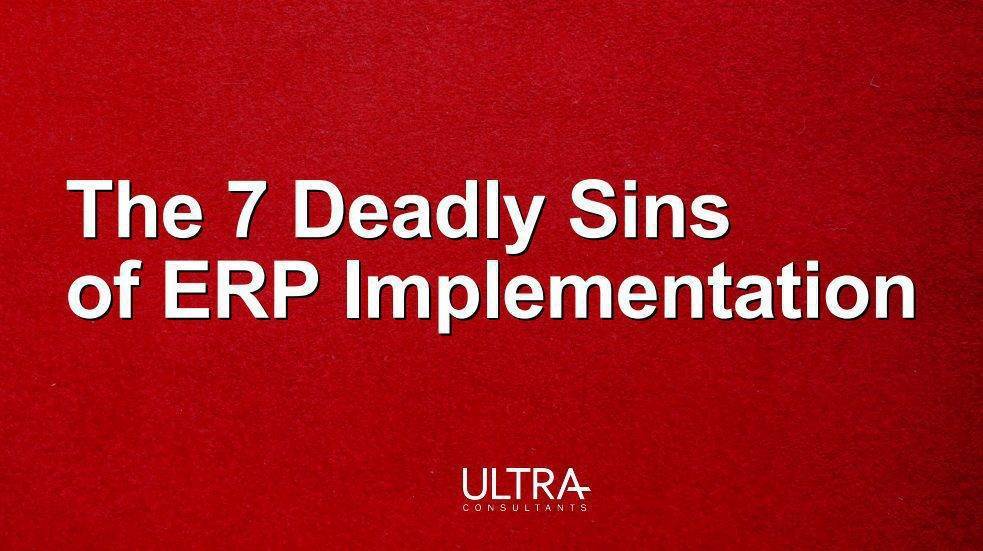In our experience as an independent ERP consultant team, an ERP selection and implementation initiative is only successful with an understanding that the process is much more than just swapping out legacy software or tweaking a few IT solutions.
Striving to achieve a future state or implementing an enterprise system requires a focus on organizational change management.
From the hundreds of projects we’ve guided, it’s clear that change – like new software or new processes – is situational and oftentimes resisted. We hear that perspective time and again as we help guide enterprise technology initiatives at today’s leading manufacturer and distributor organization.
Summarized here are four most common questions manufacturing project teams ask about change management and ERP.

1 – What is an example of an ERP project impacted by poor change management?
For lasting change, the ERP project emphasis must be on people and processes. Success follows from a structured, purposeful approach aimed to help transition people, teams, and organizations from their current state to the desired future stat
As an example of a project impacted by poor change management, a $100 million global medical testing equipment manufacturer was looking to restart a failed ERP selection and implementation project. The company was grappling with this failed project for more than eight years – one of the lengthiest “failures” we’ve seen!
The original software selection was performed without an agreed to future state which was a key misstep. Also lacking was a consistent direction to the project team about the goals of the project – was it to simply duplicate existing processes or drive best practices to a desired “future state?”
Multiple factors combined to slow down and eventually halt the ERP project, including lack of coordinated team activities which resulted in siloed decision making. Project staffing was also a contributing issue. The core project team did not have the proper allocation of time or resources to work effectively.
Ultra was called in to help mitigate these “people-related” issues with great success. Read more about change management and ERP lessons learned.
2 – What is a “low hanging fruit” easy win that companies often miss in change management?
First off, Ultra feels very strongly that change management is not just a phase. Instead, change management must be woven into the fabric of methodology, and built into project plan and team culture throughout every phase of a technology project. It’s key to be continuously aware of change promoters, adopters, influencers, and resistors as they transition from current to the future state.
That said, one of the best and most effective strategies is to take the time to establish an ERP project charter. A project charter is the ERP team’s concise statement of core goals, objectives and intent. A charter serves as the “map” for everything that comes next.
The charter outlines the compelling business case for change, and answers the question: “We are doing this project because of….” Everyone must be aligned and intimately familiar with the business case and the vision of the project. Unfortunately, this fundamental and foundational step is often missed.
3 – For technology leaders, what is the most significant blind spot of change management?
A new technology selection and implementation usually involves some shifting of roles or reallocation of work. Some users will find they have more to do under the new ERP system. Others will find their responsibilities decreased. Both of those situations can be unsettling to staff.
Thus, a key “blind spot” is when leadership misdirects the project emphasis on technology, such as infrastructure, data, features/functions and other technological considerations, without considering the full scope of change – people, process and technology.
To overcome this blind spot, it’s imperative to consistently communicate the “Why” of the project with ongoing education to build the foundation to help manage change.
Take the needed time to establish the project team, the resources, the process and organizational commitment to ensure that staff can function as “change agents” within the company as opposed to those that block or resistance to change.
4 – What is an “early warning sign” that an IT project is likely to produce poor results?
Turning to the example of the $100 million global medical testing equipment manufacturer cited earlier, the early warning sign in this particular project was a lack of a Future State vision.
All the key stakeholders involved in the failed project, which limped along for eight years, never achieved consistent alignment as to the vision, goals, or the desired Future State vision which should have defined future business processes, a future system context, and a long-range transformation plan.
This issue could have been resolved if the project focus were business process improvement at the very start.
Your Questions About Change Management and ERP
Have questions about change management and ERP? See these educational resources including webinars, case studies and white papers for examples of innovative manufacturers driving innovation, and how Ultra’s ERP system selection add value.
As an ERP consulting firm serving manufacturing and distribution teams, we are committed to the success and health of this important industry sector – with services focused on change management.
Contact Ultra Consultants to start your technology-enabled transformation.
The 7 Deadly Sins of ERP Implementation
Some mistakes are just bad strategic or financial decisions. Some are the inevitable consequence of situational or organizational factors. Some, however, are the result of process-oriented or people-centric choices – and are easily avoided. These are The Seven Deadly Sins of ERP Implementation.
Table of Contents
More ERP material...
AI in Food and Beverage Manufacturing
Discover how AI is revolutionizing food and beverage manufacturing, enhancing quality, reducing…
How ERP for Quality Control Eliminates Manual Documentation Chaos
This post will examine why managing quality records outside of an ERP…
Assessing Your AI Maturity
This article breaks down how businesses can measure their AI maturity to…




